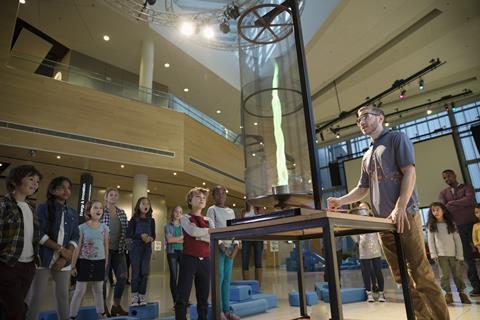Show your students their future career in chemistry. It’ll enthuse them and fulfil Gatsby benchmark 4

As a secondary school science teacher, I saw the full range of reactions of young people to my chemistry lessons. Many were engaged and inquisitive, some even enthusiastic! But there were many who were less enthused and apathetic. They didn’t see the point and didn’t think it was for them. I often felt that showing young people how chemistry isused in real life was a great way to increase engagement. Speaking to teachers across the country, this desire to provide more inspiration from outside the classroom for young people inside the classroom is a common thread.
We also know that getting young people to consider careers in science is a challenge. Whichever way you look at it there aren’t as many young people pursuing a career in science as we need, and this is particularly felt in the physical sciences. There have been some positive steps, such as the release of the government’s Careers strategy and the adoption of the Gatsby benchmarks, which give schools and colleges a simple list of benchmarks to assess their careers and enterprise provision.
We also know that getting young people to consider careers in science is a challenge. Whichever way you look at it there aren’t as many young people pursuing a career in science as we need, and this is particularly felt in the physical sciences. There have been some positive steps, such as the release of the government’s Careers strategy and the adoption of the Gatsby benchmarks (bit.ly/2GunFlw), which give schools and colleges a simple list of benchmarks to assess their careers and enterprise provision.
Every school and college in the country will be offered support to meet these benchmarks through The Careers & Enterprise Company, and they can help in several ways. Speak to your careers leader to see if your school is already engaging with the Careers and Enterprise Company.
As a classroom teacher benchmark 4 – linking curriculum learning to careers is the benchmark you have the biggest influence on. This benchmark is about bringing chemistry careers into the classroom and connecting the subject to the wider world. It can be delivered in several ways:
1) As a stand-alone subject, eg PHSEE or specific careers education.
2) Through co-curricular activities, such as a STEM clubs.
3) Through specific subjects. eg personal financial planning skills taught in maths, self-presentation skills taught in English. This approach provides career learning and enhances the subject learning, eg by showing how a reaction is used in the real world.
Your school’s careers leader can help deliver as a stand-alone subject, and STEM Learning can support with setting up stem clubs, but it is delivery through specific subjects where there is the most scope in lessons.
Your school’s careers leader can help deliver as a stand-alone subject, and STEM Learning (stem.org.uk/stem-clubs) can support with setting up stem clubs, but it is delivery through specific subjects where there is the most scope in lessons.
A future in chemistry
The Royal Society of Chemistry provides a useful resource to help highlight some of the different opportunities in chemistry and there are many ways to use it. The A Future in Chemistry case studies highlight the range of different options available in the sector. From flavourist and sports scientist , to founder of a Halal skincare brand there is a huge range of careers that I didn’t know existed!
Starter activities – Use the case studies to introduce topics and set the scene for what you are going to study. For example when teaching chromatography show students the forensic scientist as a starter to get them thinking about what techniques they could use to investigate crimes.
Plenary activities – When studying a particular topic, use a case study to check for learning; for example with acids and alkalis, use the household goods scientist case study. Not only is this a different way to check for learning but it would give young people an understanding of why their learning is relevant to the day-to-day world.
Cross-curricular activities – Careers don’t fit neatly into subject bands, and this is as true in chemistry as any other subject. The case studies link learning to other subjects. Highlight the importance of chemistry to the environment by looking at the work of a sustainability manager or build in communications skills by looking at the work of a science communicator.
All the case studies will help to broaden horizons – the limit really is our imagination.
Download the relevant curriculum links document as a pdf below to discover which case studies fit where.
All the case studies will help to broaden horizons – the limit really is out imagination.
Download all the case studies as pdfs: rsc.li/1jXhUiW
Download curriculum links documents to discover which case studies fit with which curriculum: rsc.li/2zHZv6
Oli Hallam is a former science teacher and is now employer engagement manager at the Careers & Enterprise Company
Downloads
AQA curriculum links
PDF, Size 0.12 mbOCR curriculum links
PDF, Size 0.12 mbCIE curriculum links
PDF, Size 0.12 mbWJEC curriculum links
PDF, Size 0.12 mbHigher curriculum links
PDF, Size 0.2 mbCEA curriculum links
PDF, Size 0.13 mb









No comments yet